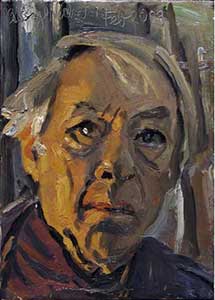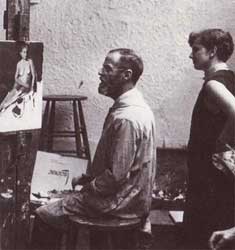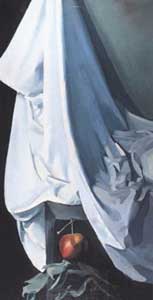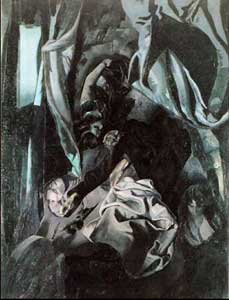
George Nick 1 Feb 2009 2009 oil on linen 14×10 inches
George Nick hardly needs an introduction; he is one of the most respected contemporary realist painters working today. George Nick’s work is included in the collections of the Metropolitan Museum of Art, New York; the Museum of Fine Arts, Boston; the Hirschhorn Museum; and the Corcoran Gallery of Art in Washington D.C., as well as many other important collections. He shows at the Gallery Naga in Boston and shows in many other leading galleries in New York and around the world.
He paints exclusively from observation, often works on large scale paintings either from his truck studio or directly outside. If you are curious about his background and more information about his approach to painting there is an excellent essay on GeorgeNick.com, En Route with George Nick by Christopher Chippendale, which gives a biographical sketch as well as insight into his art. There are also other essays there by other art critics and writers, including an essay by John Updike and an interview with John Arthur. Additionally, his website has much of his work starting from the early 60’s up to his current work. George Nick has lived in the Boston area since the late 1960’s and taught at the Massachusetts College of Art for over 30 years. I studied under him in the mid-80’s and he has been a mentor and friend since that time.
I asked George if he might agree to an interview for Painting Perceptions and needless to say I was delighted when he agreed. This generosity of his time is typical for him as over the years he has gone out of his way to help countless painters move forward with their vision, skills, careers and lives.
Since the interview was long I decided to break it up into sections to make the reading more manageable. Please note, for this interview I made the images clickable, unlike the rest of the blog, so that you can see the larger images. I’ve also made a “podcast” audio recording version available here for people who would also like to listen to the interview away from their computer. George and I did edit the interview slightly for greater clarity, so there are a few differences from the written to the audio version (the audio podcast is slightly over an hour long).
[podcast]http://gnick_interview.s3.amazonaws.com/georgeNickintervAll.mp3[/podcast]
Part One, On Edwin Dickinson

Edwin Dickinson teaching at the Art Students League 1954 photo by Denver Lindley, from Edwin Dickinson, Dreams and Realities
Larry Groff:
You studied with Edwin Dickinson at the Art Students League in the late 1950s. What was it like to study with him? Is there any one thing that he said, or some aspect of his teaching, that was most influential to you?
George Nick:
Well, first of all, it was wonderful to study under him, because he was very intelligent, very thoughtful and a sensitive person. He was careful dealing with people. He never pushed his ideas on anyone at all, ever, and that was really surprising.
Little by little it came out, when he was talking to you, if you wanted to do this, you should do it this way, that would always begin something like that, “Is this what you want? Maybe I can help you with this.”
He had a lot of things that he did. There isn’t any one thing. There was an attitude that he had, that was the most influential for me, was that he believed in what he was doing, and that is what he taught. He knew how to look and he told you what he knew. He just had a very good character.
[He] passed on information at the time it was necessary. He never talked too much, and he wouldn’t cover many things, but he covered what was important at the time, and let you soak it in, absorb it, and see how you dealt with it.
He would wander in, late in the morning, after we’d started painting. We would have one model, one pose for all semester. If you wanted to study as much as you want, you could paint it. If you wanted to paint another figure, you just went from another angle.
We had drawing classes, once in a while. They were like three-minute drawing classes, but you had to draw one curve or one part of the body, and he would correct that. He’d just walk around and see one line, what part of the body it was. He’d figure out, if you could draw that, you could draw anything. Drawing, to him, was very crucial. He always said, “Drawing is how high by how wide by what angle. Everything is that, and if you can do that, you can draw anything.”
The things about aesthetics, I always felt that he wasn’t teaching. I always felt he wasn’t teaching about art; I felt he was teaching about mechanics. He would never give opinions of other artists or anything like that, or about art. He just talked about how to see something, how to make it and how to mix; how to clean your palette.
I remember when I invited him to Yale after I hadn’t seen him for a couple of years, and we could invite anybody, and I invited him. He was very proud to come there. I remember Janet Fish was very annoyed with him. All he did was tell her how to clean her palette.
LG:
So did she then start cleaning it properly?
George Nick:
I never knew what happened after that. I know she complained about that, and that’s the only comment I got from anybody who had him critique them, as he went around.

George Nick Sheet with Apple 1959 oil on linen 40×20 inches
LG:
Did he give a slide talk at Yale?
George Nick:
No, he gave a talk that nobody understood. I didn’t even know what he was talking about. It was very weird. At one point, some fellow raised his hand and interrupted him. He didn’t yell at him; he put his hand up. He turned up and looked at him, Dickinson looked at him, and he said to Dickinson, “Can you tell us what art is?”
He sort of got a glazed look on his face. For about a minute, everybody was waiting around and waiting around He sort of ignored the question, then went on talking. After about ten minutes, the same fellow put up his hand, and said to him, “Does that mean you’re not going to tell us what art is about?”
George Nick:
So he was pushed into a corner. After, again, another minute — we didn’t know what was going to happen next — he said, “Art is the organization of shapes.” Everybody waited for him to continue; but there was nothing else after that, and that was it. He tried to get as fundamental as possible, and be true about it, real about it.
LG:
Good for him. Do you think he’d be able to get away with that today?
George Nick:
He would get away with anything. He had a wonderful air about him, and he was very confident. I had him first in night class, at Brooklyn Museum Art School, and there was one girl that wanted him to teach her how to paint like Renoir. And so, he went over there, and taught her how to paint like Renoir.
LG:
Really.
George Nick:
It must have been something — the way I looked, or something like this — I was a young turk. I was in the corner, and he came over to me, and said, “George, there’s room for everybody in this world,” in this sweet way, of course. I never forgot that. It never helped me, but, I never forgot that.
Another one — it was a like a truck driver, or something like that — made fun of him because he had a beard. Nobody wore beards then, in the ’50s. And he said, “If I had a quarter for all the time I’ve been picked at because of the beard, I’d be rich,” he said.
He was always easy-going. He loved students and he always came in happy.

Edwin Dickinson Self Portrait, 1954 1954 oil on canvas 26×24 inches
LG:
You wouldn’t think by looking at his self-portraits.
George Nick:
Well, I think he’s being theatrical. Don’t you think?
LG:
Did he dress rather eccentrically?
George Nick:
No. Well, he had a jacket on, and he had dungarees on, and he had a tie that was like an artist’s tie; tied together. He told me he bought it at an Army Navy Store in 1917 for seventeen cents. Things like that.
I mean, they were always poor, until he had a couple of shows, near the end of his career, and then the museums bought his work.
Once when we were there, they exhibited all his paintings at the same time, the Modern Museum of Art, the Whitney and the Metropolitan. They exhibited them, and the students asked, “Why don’t we go together, with the class and you, to see the paintings?”
He said, “Of course. I’ll do anything that you like.”
He spoke in an old English. I asked him once why he spoke so wonderfully, and he said, “Well, my father was a preacher.” And he spoke like that.
George Nick:
Once I asked him — before I get on with that other story — every time he gave a crit, I would stop painting and listen to him, because he was always saying something pertinent about the students paintings. So, I would listen.
Once I asked him, “How did you ever learn to teach?”
He said, “You know, when I was given my first job, I never taught before. I didn’t know what to do, so the day before, when I was out painting, after I was through painting, I recited to myself what I had done.”
And that’s how he started teaching.

Edwin Dickinson The Fossil Hunters 1926-28 oil on canvas 96 x 73 inches
George Nick:
Anyway, there are other stories that have nothing to do with art, except that it had to do with his attitude towards not divulging anything personal about his painting.
In one painting that had a nude, and rippling water: there’s some sort of a hole in the steps and something falling through it. There’s some sails, draped. He was telling us that the water, he spent a long time in drawing a perspective drawing of the rippling, elliptical waves of water coming out — that something had fallen in the water and was making waves, little ripples.
Of that painting, he said, “One critic, wrote about this painting, that, that was either a flower or a hot coal falling through.” We went to look at it, and when we turned around, he had walked away. That was all he was going to tell us about his painting.
There was another large painting — I’ve forgotten what it is — it had these two big vases, pitchers, and they were very different in tonality and a little different in color. He said, “You see, this one was painted outside of Buffalo and this one outside of Cape Cod. Do you see that?”
And we all said, “Yeah, sure.” One couldn’t see any difference.
LG:
Do you have anything else to say?
George Nick:
I don’t know if I could explain it, but he was a wonderful teacher, because he said things I wanted to learn, wanted to know. I think I remembered a lot of the things that were very important to me, and I taught them for over forty years from these things that he taught us: how to squint, how to draw, how to mix colors, how to recognize warm and cool, how to apply paint and how to see and how to analyze what we saw.
He taught us to apply paint with our fingers. The paintings I have in my studio, the early paintings I have are all painted from the side of my little finger, except for a couple of parts that need brushwork, very sharp brushwork. The whole thing’s painted from ….
So I learned a form of aesthetics from him about the quality of paintings.
LG:
Did he have you use a knife a lot?
George Nick:
Oh, we did use knives. We did everything. It wasn’t a lot. Everything was a tool, and everything was necessary at a time when you wanted it and needed it. But now I mostly use one big brush.
To Interview with George Nick, Part Two, On Fairfield Porter
To Interview with George Nick Part Three, On George Bellows
To Interview with George Nick Part Four, On Cezanne and color
To Interview with George Nick Part Five, On Drawing
To Interview with George Nick Part Six, On The Trojan Horse and thoughts on Teaching





Oh boy, this looks like its going to be great!
Don’t have time to read it now, but Nick is one of those painters who has been doing top notch work for many, many years. That impresses me, a lot. I look forward to digesting these interviews. Thanks for this Larry.
I’ll be looking forward to reading the other interviews with GN, Dickinson was one of my mother’s favored painters. Fascinating- thanks for posting.
Edwin Dickinson and George Nick, two of my favorites. As students at the Pennsylvania Academy of the Fine Arts (in the earley 1980’s) we all know George Nick’s work. It was a pleasure to get to meet George when he came out to Seattle to teach a work shop. A friend, the artist Scott Noel, told me that he was coming West and gave me a number to reach him.
I hear about shows that George is having and we have had some correspondence in the past. I hope that all is well with George Nick in Concord MA and that the painting is going well.
Had the opportunity to study under George Nick at Mass Art a few decades ago but didn’t because he was offputting. In retrospect, I wish I could have put personality aside, because his paintings have so much to offer. Billy
I studied at MassArt (undergrad) and took a few classes with George. I went to Queens College for Grad school on his reconmandation. It was the best thing I could have done. I’ve always wanted to thank him. Thanks George! I show at the Bowery Gallery, and Gross/McCleaf. and teach at a small college in central PA. I try to see Georges shows when I can. I was an older student who need more independence so I though. I did not study with him directly yet he has been a major influence on me. Thanks for the artical and venue to say thanks.
Thanks for this great interview. Both are painters whose work I’m really interested in. This has got me really wondering how Dickinson cleaned his palette!
This is fabulous! What a resource!
I worked with George at Eastman Kodak in Rochester NY. We worked the 4-12 shift in the Roll Coating Department. I first saw
George reading Art History books in his work area: sitting with feet resting on desk top, in full view of all who passed by on their way
to the cafeteria,engineering offices etc. A high traffic area. His job was thoroughly cleaning the large metal canisters, hung from an overhead track, that would contain the newly cast film base. I was on the crew that was cleaning the large space to ensure a dust free environment. Enough mid-50s back story. I ended up modeling for George who gave my mother a portrait of me in lieu of payment.
George, along with my former art teacher Emil Mauer, was instrumental in encouraging me to follow the Cooper Union/Art Leage path.
I did initially, but ended up at the Crafts School at RIT. Eventually had a teaching career at UNH ( Woodworking, Furniture Design &
3-D Design ) for 40 yrs. Retired in 1999. All this to get to my message to George himself. During the Boston Symphony concert this
week-end, I will recall the modeling session we had to the accompoment of the Prokofiev 5th. Like George I work while listening to
classical music. We shared Inter-High & Eastman School Prep. Dept experiences. Long live 99.5 !!!!! And torpedo fights !!!
I enjoyed reading thks interview very much. I particularity like the answer Edwin Dickinson gave to the question” What is art”? Pretty thought provoking. George does have a reputation for being off puting, as someone commented but reading this interview made me reassess my own similar impression. George repeatedly comments on Edwin Dickinskn’s good character and kind nature and I have a feeling that knowing George better would disclose a kindness not so terribly visible at first glance.
Jack
I enjoyed reading this interview very much. I particularity like the answer Edwin Dickinson gave to the question” What is art”? Pretty thought provoking. George does have a reputation for being off puting, as someone commented, but reading this interview made me reassess my own similar impression. George repeatedly comments on Edwin Dickinson’s good character and kind nature and I have a feeling that knowing George better would disclose a kindness not so terribly visible at first glance.
Jack
What seems significant to me is that the period of George’s working with E Dickinson had such significant impact on him and his paintings and teaching
It shows me that the significance of fundamental principles are so powerful as George’s work attests
Teaching others how to see in a accurate perceptual manner is what then informs the translation of it into the terms of painting.
For me the excitement of painting is to keep an authenticity to both the seeing and the making.
George is a role model as is E Dickinson too for painters for many decades.
Thanks Larry for the interview with George. Hearing his comments and insights ring so true to me.